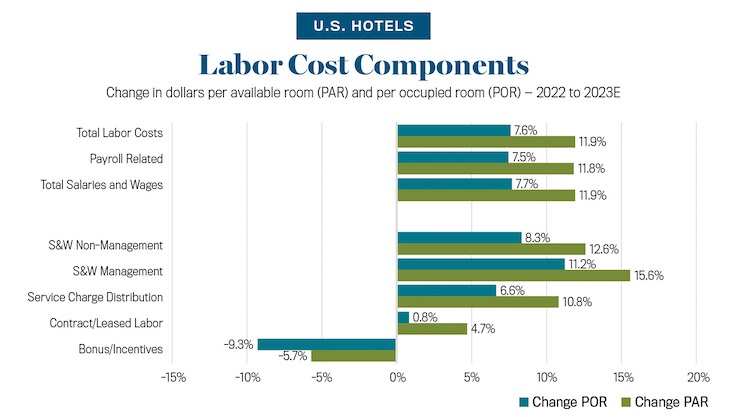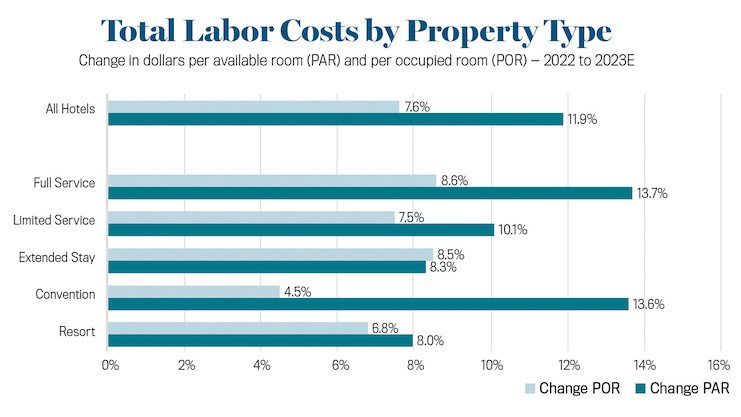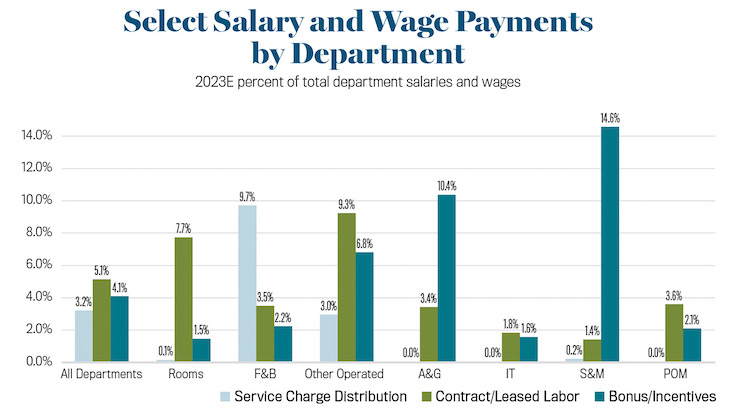The scarcity of employees has long been the primary labor concern for U.S. hoteliers, even before the onset of the COVID-19 pandemic. Historically, jobs in the lodging industry have had a negative perception as being too physically demanding, requiring excessively long hours, and requiring work on weekends and holidays. The shortage of personnel was exaggerated during 2021 and 2022 as many of the employees that were laid off during the pandemic in 2020 opted not to return to the industry.
The difficulty of attracting workers to fill line-level positions within hotels lessened somewhat in 2023. Reductions in hotel amenities and services, more efficient use of technology, longer lengths-of-stay, and enhanced training have enabled hotels to operate with fewer employees than they have in the past. On the other hand, executive committee-level positions are staying open for record periods of six months or longer, in many cases negatively impacting performance.
While hotels have adapted to lower levels of applicants and staffing, new labor-related issues have surfaced as a challenge to owners and operators:
- Hourly wage rates and salaries are rising at a pace greater than revenue.
- The negative industry perceptions are making it hard to retain talented employees and fill management positions.
- The younger workforce is seeking employers that offer flexible work hours and locations, as well as a company that is sensitive to environmental, social, and governance issues.
- Shortage of talent at the executive committee level is putting upward pressure on some of the highest salaries in a hotel and impacting performance due to key positions staying vacant for longer periods.
The impact of these issues was evident in the 2023 operating statements of U.S. hotels. For the year, we observed rising labor costs, declines in bonus payments, decreased use of leased labor, and implied lower levels of staffing.
To analyze recent trends in U.S. hotel labor costs, we examined the 2023 salary, wage, and employee benefit expenditures of 2,456 hotels that participated in CBRE’s Trends in the Hotel Industry survey as of March 2024. In 2023, these properties averaged 221 rooms in size, with an average occupancy level of 68.8 percent and an ADR of $220.01.
Salaries and Wages
Total labor costs for the survey sample increased by 11.9 percent from 2022 to 2023. During the year, salaries and wages (11.9 percent growth) and employee benefits (11.8 percent) grew at similar rates.
The greatest percentage increase in labor costs was seen in the food and beverage (F&B) department (14.5 percent). F&B revenue lagged in 2021 and 2022, but the return of group demand in 2023 stimulated a rise in banquet revenue. Increased F&B volume in both outlets and catering contributed to the rise in F&B labor costs.
The relative recovery of property types also influenced their needs for employees. The return of group demand, along with limited increases in individual business travelers, helped boost the labor costs of convention (13.6 percent) and full-service (13.7 percent) in 2023.
These labor cost growth rates are greater than the 8.6 percent rise in total hotel revenues and the 10 percent increase in total operating and undistributed expenses during the same period. Accordingly, labor as a percent of revenue increased from 31.4 percent in 2022 to 32.4 percent in 2023. As a percent of expenses before gross operating profits, labor costs grew from 50.9 percent to 51.7 percent.
From 2022 to 2023, the salaries paid to managers increased more (15.6 percent) compared to the total wages paid to non-management employees (12.6 percent). The increase in management salaries can be partially attributed to the increased challenge of retaining managers.
Staffing
While total labor expenditures are rising, it appears that staffing levels are down. Combining CBRE Trends data with information from the Bureau of Labor Statistics, we estimate that the average hotel in our sample operated with 5.9 percent fewer employees in 2023 than in 2019. Over that four-year period, total labor costs increased by 17.7 percent, while the average hourly compensation rate for a hospitality employee grew by 29.4 percent. This trend of lower staffing levels has been verified during conversations with our clients.
Other Compensation
Besides salaries and wages, the CBRE Trends survey tracks three additional compensation subcategories within each operating and undistributed department of a hotel. These subcategories are consistent with the 11th edition of the Uniform System of Accounts for the Lodging Industry (USALI):
- Service Charge Distribution
- Contract, Leased, or Outsourced Labor
- Bonuses and Incentives
Payments made to non-management employees from mandatory service-charges increased the most (10.8 percent) among these three subcategories during 2023. To boost revenues and employee pay during the industry recovery, hotels have increased the use of mandatory service-charges in the F&B and other operated departments (spa, golf, etc.).
While the payments made to contract and leased employees increased by 4.7 percent in 2023, this cost as a percent of total salaries and wages declined during the year. This indicates less of a dependence on the use of this expensive source of staffing. However, this statement does not hold true for certain markets where agency labor is still predominant and costly.
As expected, bonus and incentive payments are most frequently found in the administrative & general and sales & marketing departments. The slowdown in pace of revenue and profit growth from 2022 to 2023 resulted in a decline of 5.7 percent in bonus/incentive payments.
Not Just a Cost
Employees are not just the greatest expense for hotels, but they are also an integral part of the product and service offering. Rising labor costs are not just influenced by increasing wage rates, but also changes in hotel amenities and services, the use of technology, guest preferences, and employee needs and desires. Accordingly, managing labor expense is not just a function of controlling costs. It also requires a holistic understanding of operational and societal factors.



